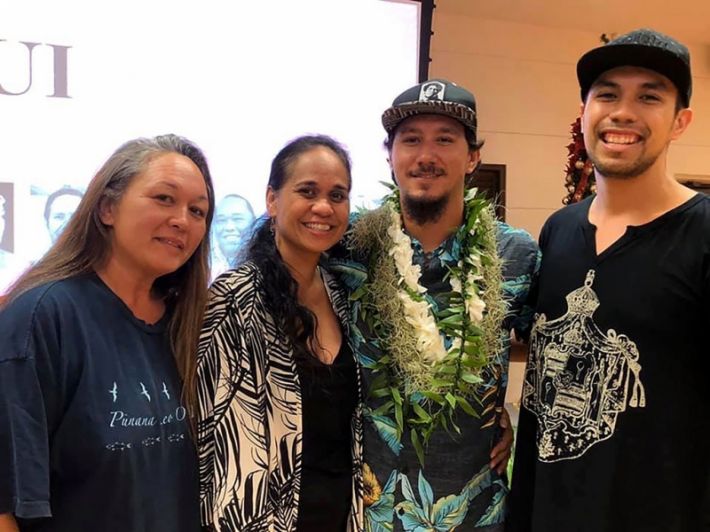While they are separated in age by nearly three decades, Molokaʻi-born Luana Busby-Neff and Kahoʻokahi Kanuha from Moku o Keawe share a love for and commitment to preserving the intergrity of the ʻāina, its natural resources, the lāhui and Native Hawaiian heritage that transcends generations.
The Native Hawaiian leaders led an engaging discussion focused on “Kapu Aloha Perspectives on Aloha ʻĀina” at the November 25 edition of Lāhui Rising, the educational forum that drew more than 200 haumāna, kumu, ʻohana, alumni and community members to Kamehameha Schools Kapālama’s Ka‘iwakīloumoku Hawaiian Cultural Center.
According to Busby-Neff and Kanuha, Kapu Aloha is a respectful, non-violent code of conduct that in the face of adversity requires discipline and constraint while also fostering respect and aloha. With worldwide attention on Maunakea, as well as exposure to the kapu among the tens of thousands who have journeyed to Puʻuhuluhulu, the mana and impact of Kapu Aloha has gained visibility around the globe.
“It was the kūpuna who set the rules for all of us at Puʻuhuluhulu,” said Kanuha, a 2007 KS Kapālama graduate. “Kapu Aloha is not just about non-violent behavior, but it requires ceremonial protocols, focus and discipline. With thousands of supporters coming to the Mauna every day for several months, this kapu was extremely challenging to enforce. If just one person threw a pōhaku in anger, that would have been it.
“The powers that be (law enforcement) are not trained to handle this kind of non-violent protest. They show up in force with batons, clubs, guns, pepper spray and the like, and are greeted with respect and aloha – sometimes even as ʻohana and neighbors.”
Busby-Neff knows ceremony and protocol well, and chanted mele recounting the origins of Maunakea through such cosmogonic genealogies as the Kumulipo and other traditional texts that establish Maunakea as the child of Wākea. Busby-Neff described Kapu Aloha as “an elevated mode of conduct," and noted "that with deep love and commitment to what you are doing, you can change anything.”
Examples of practices similar to Kapu Aloha are reflected throughout Native Hawaiian history. In the wake of the Jan. 17, 1893 overthrow of the Hawaiian Kingdom government, Queen Liliʻuokalani, hānai sister of Princess Bernice Pauahi, peacefully yielded her authority under protest in order to avoid bloodshed and loss of life. Even in the darkest of times, Queen Liliʻuokalani's steadfast compassion for her people and unwavering faith set a lasting and noble example for Hawaiʻi and the world around the mana of aloha.
Kaʻiwakīloumoku’s Lāhui Rising Series continues this Friday (Jan. 17) with ‘Aha Mele Makahiki, a celebration of music and hula marking the season of Lono. Performers include Del Beazley, Kumu Hula Kaleo Trinidad and the KS Kapālama Hawaiian Ensemble, Hālau Kū Māna and more.
Videos of two additional Lāhui Rising presentations in October and December 2019 are available on KSʻ Facebook page: "‘Ōiwi Agency: Pathways Toward Leadership" (10/18) featuring Dr. Jon Osorio and Dr. Kamana Beamer; and "Kealaikahiki: Illuminating Ancestral Pathways to Kahiki" (12/03) featuring Kekaulike Mar, Dr. Kaleomanuiwa Wong, Snowbird Bento, Dr. Keao NeSmith and Dr. Herman Piʻikea Clark.
The Lāhui Rising series is produced by the Kaʻiwakīloumoku Hawaiian Cultural Center and is designed to create a respectful, safe and enriching learning space for students, staff, alumni, families and our community, to hear and honor different voices and perspectives on matters of Hawaiian interest for the purpose or education.
Mahalo to KS Hoʻokahua Cultural Vibrancy Group Cultural Consultant Manu Boyd for the contribution.

Gina Peterson (left), Noelani ʻIokepa Guerrero, Kahoʻokahi Kanuha, Kahōkūʻalohiokeao Lindsey-Asing engaged in “Kapu Aloha Perspectives on Aloha ʻĀina” at the November 25 edition of Lāhui Rising.
TAGS
native hawaiian identity,
'ōiwi leaders,
alumni success
CATEGORIES
Kaipuolono Article, Themes, Culture, Community, I Mua Kamehameha, Newsroom, Kapalama, Community Education, Community Events, Department News, Features, Alumni, Oahu
Print with photos
Print text only










